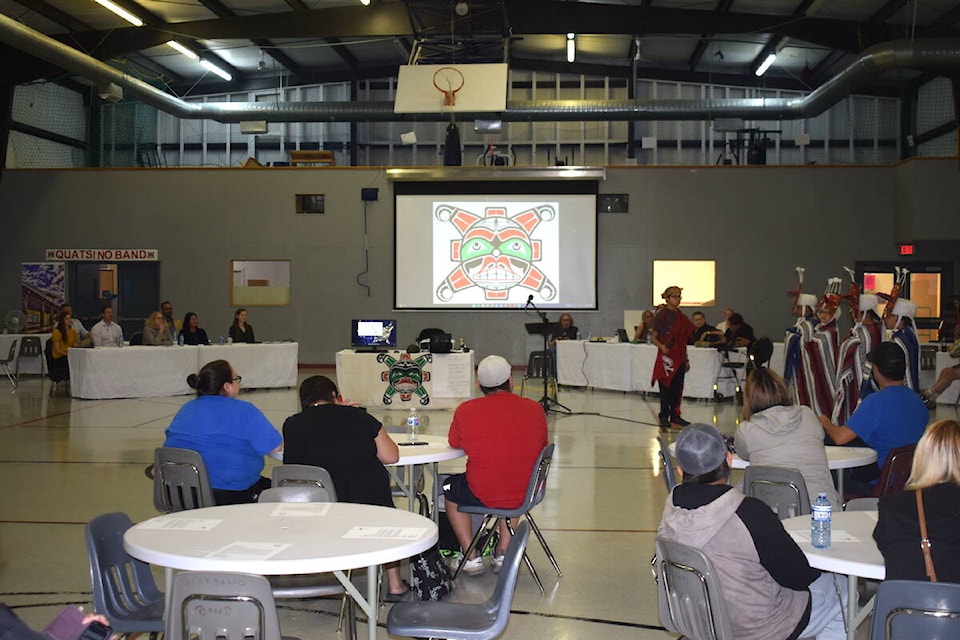A multi-national mining company has issued a public apology to the Quatsino First Nation for longstanding damage done to its traditional territory during operations of the Island Copper Mine.
The open pit mine is located deep in Quatsino ancestral lands on Northern Vancouver Island, and at one point it became the lowest man-made place in the world during its operations between 1971-1995.
During its 24 years of existence, the mine removed roughly one billion tonnes of ore, before it eventually closed in 1995 and then flooded with ocean water. No royalties were paid to the Quatsino First Nation, and there was no consultation on the project that ultimately destroyed much of the sea life around the beach in front of their village.
Once flush with an abundance of sea life such as urchins, ling cod and abalone, the nation says they were all wiped out by all the dumping of waste rock over the span of the mine’s existence.
BHP, who acquired the Island Copper Mine back in 1984, sent a group of representatives to travel to Quatsino to issue a formal apology to the nation on Tuesday evening (Sept. 20).
“Today I’m honoured and humbled by this invitation to be with you all, and my hope is to convey this sincerity that underlies our visit to your community,” Kate Sommerville, BHP’s general manager, legacy assets, said to the crowd of Quatsino First Nation residents who were in attendance at the community hall. “This is the first visit with you, we hope the first of many.”
Sommerville noted BHP wanted to acknowledge that the mine is located on the ancestral and traditional unceded land of the Quatsino First Nation.
“On behalf of BHP, I come to your territory today to humbly apologize for past actions and shortcomings, and to ask your community for forgiveness. I hope with this apology we can start over, we can rebuild, we can work together for change, so that together we leave a positive legacy for the generations to come.”
Sommerville added BHP deeply regrets the mine’s lack of consultation and involvement with the Quatsino First Nation that has affected their community. She stated past practices at the mine “fell short of the standard of which we aspire to today, and this led to a relationship of mistrust that hindered the development of a collaborative relationship between BHP and the Quatsino First Nation.”
BHP is promising to collaborate on remediation efforts and environmental monitoring in order to reset the relationship with the nation.
“We view this apology as the first step, and we will continue to take meaningful actions to nurture our relationship and to work together in respect, transparency, and collaboration,” stated Sommerville. “It is our sincere hope that we can move forward together, on the grounds of a refreshed relationship to create a prosperous future for the Quatsino First Nation.”
Chief Tom Nelson spoke later on that night about how after the mine had started operation, the Quatsino people were left with nowhere to go to harvest food sources.
“It’s my turn to let you all know what BHP did to our food chain out here,” Nelson said, noting how they used to be able to harvest food for trade at various traditional spots before the mine opened “and polluted the waters.”
Nelson continued, stating that due to losing their food chain, “the generation here today, they do not even know how to go out there and harvest any of this stuff because it isn’t there for them.”
“We do have a lot to talk about with BHP to compensate us [for] what we lost, and in the next few days we will be having some heavy duty meetings to discuss [compensation] with BHP,” added Nelson.
After questions from residents, some visuals of the mine site and affected areas around it were shown via slideshow, before Sommerville was given the mic to issue a response.
“Thank you for coming tonight to take the time to tell us stories, ask us questions, and also raise concerns,” she said. “We have heard a lot this evening, and our team has been taking many notes.”
Sommerville added BHP will be starting as soon as it can to demolish the infrastructure at the mine site, clean up spillage, and restore the fish habitat so the company can hand the area back to the crown who will “hand it back to you.”
“Today was our first meeting, and we are going to be continuing discussions tomorrow, and that’s when we are going to begin to talk about opportunities for shared value.”
editor@northislandgazette.com
Like us on and follow us on



